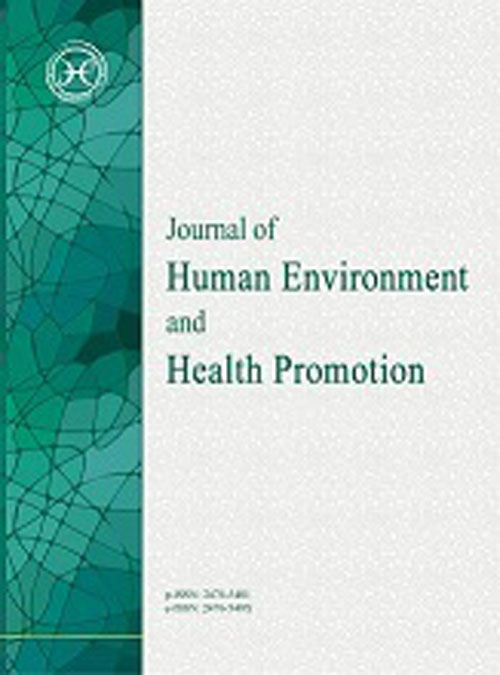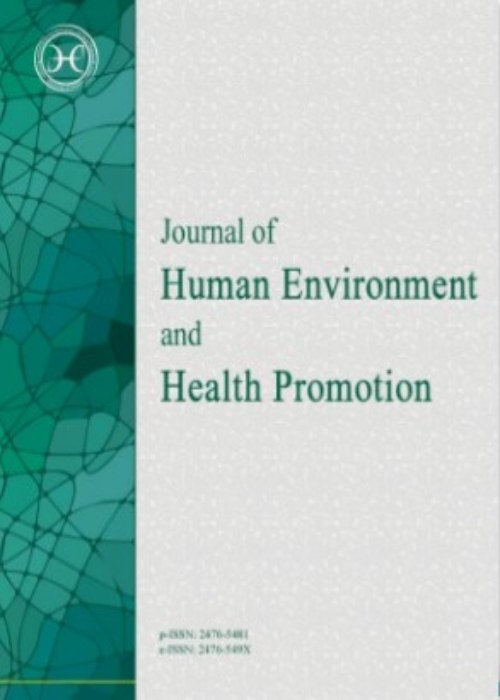فهرست مطالب

Journal of Human Environment and Health Promotion
Volume:7 Issue: 4, Autumn 2021
- تاریخ انتشار: 1400/10/30
- تعداد عناوین: 8
-
-
Pages 173-181Background
This research was conducted to evaluate the effect of Piriformospora indica (P.indica), drought, and soil salinity stress on diesel oil biodegradation in a soil that was polluted with Pb and Cd.
MethodsTreatments consisted of corn inoculated with P.indica and white clover intercropping system under the salinity (3.1 and 6 dS/m) and drought (normal and intensive) stress which cultivated in the Pb and Cd polluted (naturally) soil which simultaneously contaminated with diesel oil at the rates of 0 and 4 % (W/W). After 10 weeks, plants were harvested and the diesel oil biodegradation in the soil was determined. In addition, the soil microbial activity, the APX and POX enzyme activates were measured.
ResultsDiesel oil biodegradation significantly increased in the soil under cultivation of plants inoculated with P.indica, while it significantly decreased under salinity and drought stress by 12.9 and 9.8%. However, the intercropping system had positive effects on increasing the soil microbial activity and biodegradation of diesel oil in the soil.
ConclusionCorn inoculation with P.indica significantly affected the biodegradation of diesel oil in the heavy metals and petroleum hydrocarbon polluted soil that is under salinity and drought stress.
Keywords: Diesel oil, P.indica, Salinity, Drought, Biodegradation -
Pages 182-188Background
In this study, the efficacy of riboflavin (VB2) in preventing uterus As2O3 damage was investigated for the first time in the literature.
MethodsThe rats received 40 μg LHRHa for estrus synchronization. 48 pregnant Wistar rats were included in the study. Four groups were formed with 7 rats in each group: Sham, 1.5 mg arsenic trioxide (As2O3/L) alone or in combination with VB2 (20 and 40 mg/L) in drinking water (for 21 days continuously). Moreover, similar to maternal generation treatment the F1-female generation was arranged (for 35 days continuously until puberty).
ResultsBased on the results, As2O3 reduced body weight and feed intake (P < 0.05). Furthermore, the serum malondialdehyde levels in the As2O3 group were significantly higher than that of the control group (P < 0.05). At the same time, the total antioxidative status and the activities of glutathione peroxidase, superoxide dismutase, and catalase were reduced (P < 0.05). Meanwhile, As2O3 remarkably increased the inflammatory markers production [interleukin 6 and C-reactive protein] (P < 0.05). As2O3 administration induced uterus apoptosis-related genes by upregulating caspase-3, iNOS, and Bax genes and downregulating Bcl-2 gene of pubertal F1-female rats (P < 0.05).
ConclusionOur observation indicated that VB2 therapy is potentially an effective strategy to modify the detrimental effects of As2O3 in pubertal F1-female rats via suppresses oxidative damages.
Keywords: As2O3, Inflammation, Puberty, Vitamin B2 -
Pages 189-196Background
Nowadays biomaterial has been proposed as a suitable alternative for chemical substance. It has no odor and taste and its consumption is beneficial to human health. The present study aimed to investigate the effect of application of chitosan coating individuality and along with Aloe Vera gel on the nutritional level and quality of strawberry fruit (cv. Camarosa).
MethodsAfter application treatments Aloe Vera gel (0, 50 and 100%), Chitosan (0, 0.5 and 1%) and their combination, plates contain strawberry were kept in the refrigerator with a temperature of 4 ± 1 °C, at humidity of 85- 90%. Traits were evaluated in the first days zero, 4, 8 and 12.
ResultsThe results showed fresh weight of fruit, chlorophyll, vitamin C and anthocyanin significantly affect by Aloe Vera 100%+ Chitosan 0.5% application. Also, plants treated with Aloe Vera 50% + chitosan 0.5% produced higher taste index, phenol and antioxidant capacity. On the other hand, lower weight loss of fruit, malondialdehyde and total soluble solids was observed with Aloe Vera 100 % + Chitosan 0.5 %. Storage life significantly was enhanced with Aloe Vera 50% + Chitosan 0.5% up to 15.7 days which was the same level with Aloe Vera 100% + Chitosan 0.5%.
ConclusionOverall, the application of Aloe Vera treatment 50% or 100% along with Chitosan 0.5%, would be a highly recommended practice in the maintaining the nutrition value and storage life of strawberry fruits.
Keywords: Aloe Vera gel, Biomaterial, Chitosan, Nutritional value, Strawberry -
Pages 197-204Background
Mazandaran province, with the largest coastline of the Caspian Sea in the country, draws a large number of travelers and tourists every year. This study aimed to determine and interpret the microbial health quality of its coastal waters.
Methods19 swimming points in Sari, Miandorud, Juybar, and Babolsar counties were weekly sampled for six months. Microbial testing for collected samples was performed using the MPN method and membrane filter based on EPA method 1600. The data were analyzed using SPSS software. Descriptive, normality, one-way analysis of variance (ANOVA) and LSD tests were also conducted.
ResultsThe mean of enterococcus in all the stations was standard; however, fecal coliform in P4, P1, and P0 of Babolsar was high. Normality tests of geometric mean indices, normal distribution, and results of one-way analysis of variance between stations and sampling time showed a significant difference at the level of P < 0.05. The highest contamination was observed at P4, P1, P0, Edalat 4, and Farahabad.
ConclusionDue to the presence of microbial contamination in some areas, determining fecal coliform indicator in addition to enterococci is necessary to accurately estimate the status of microbial contamination of coastal waters in the region.
Keywords: Coastal recreational waters, Fecal indicators, Caspian Sea, Mazandaran province -
Pages 205-212Background
This study was conducted to investigate the relationship between land use changes and physicochemical characteristics of groundwater in the Dalaki watershed in Bushehr province, from 2006 to 2016.
MethodsIn this study, changes in the amounts of chlorine, calcium, sodium, sulfate, and total dissolved solids were investigated. In the first step, the spatial relationships of the aforementioned parameters were evaluated and the optimal models were selected for mapping. Then, using Landsat satellite images, the land use classification was done. Finally, the relationships between land use changes and the physicochemical characteristics of groundwater were surveyed.
ResultsAccording to the analysis of the results, the highest concentration of groundwater in the studied years was observed in rainfed agriculture, palm groves and orchards land uses.
ConclusionA significant relationship can be established between agricultural uses and the increase in the concentration of groundwater physicochemical characteristics. In other words, agricultural use caused groundwater resources salinity and reduced their quality. Because of the vastness of land use, a large amount of groundwater is taken to irrigate crops. Moreover, rainfed agriculture increased and decreased the number of quality characteristics, however using planting palm trees only increased them.
Keywords: Groundwater, Mapping, Dalaki watershed, Classification, Land use -
Pages 213-220Background
Using plants for removing heavy metals from contaminated soils is an economical and effective strategy. Phytoremediation is one of the suggested methods that plants absorb and accumulated heavy elements in plants. The purpose of this study was to investigate the feasibility of Cadmium (Cd) phytoremediation from soil using Bermuda grass.
MethodsThis experiment was conducted in a completely randomized design with four levels of (Cadmium nitrate) Cd (NO3)2 (0, 20, 50, 60 mg/ kg soil) and Nickle solution (NiCl2×6 H2O) (0, 150, 300,450 mg/ kg soil) with three replications in the Research Institute of Petroleum Industry.
ResultsThe obtained results of the analysis of variance showed that metal significantly affected traits such as shoot and root dry weight, plant height, stomatal resistance, chlorophyll and antioxidant enzymes. It was also observed that Cd accumulation in plant root increased with increasing cadmium concentration. Furthur, Ni accumulation in the root tissues was higher in all the treatments than aerial parts.
ConclusionAccording to the findings, seedlings of Cyndon dactylon can be suggested for Ni and Cd remediation in polluted soils.
Keywords: Bermuda grass, Bioremediation, Heavy metal, Cd stress, Ni tolerance -
Pages 221-224Background
Electrolyzed oxidizing water (EOW) is a novel natural disinfectant. It has been suggested that applying EOW can improve the shelf life of fish. The purpose of this research was to compare the effect of electrolyzed water with a solution of alginate coating prepared/followed by EOW and examine their impact on pseudomonas aeruginosa growth inhibition in salmon fillets kept under refrigeration.
MethodsFish fillets were inoculated with pseudomonas aeruginosa and divided into six different treatment groups: control (no coating), distilled water, alginate, EOW, EOW & alginate (samples coated with alginate solution prepared by EOW), and EOW+ alginate (samples immersed in EOW, then coated with alginate solution). The fillets were kept at 4 °C, and the bacterial count was determined on days: 0, 2, 4, 8, and 12. Data analysis was performed using repeated ANOVA and Bonferroni post-hoc test at statistical significance of 0.05.
ResultsAdditionally, both the solo and combined application of electrolyzed water and alginate coating have been shown to substantially limit developing Pseudomonas aeruginosa. However, their combined usage had a greater impact than control sample. When coating solution was applied followed by electrolyzed water, the greatest decrease rate (1.27 logs CFU/g) was found in comparison to control samples.
ConclusionAccording to the findings, applying alginate coating in conjunction with electrolyzed water may be used realistically in food systems, particularly seafood.
Keywords: Alginate coating, Electrolyzed water, Pseudomonas aeruginosa -
Pages 225-232Background
Achieving a healthy society depends on a normal and efficient family. Therefore, the present study investigates the effectiveness of integrated behavioral couple therapy in improving family function.
MethodsThe current research was a semi-experimental study with a control and experimental groups including the pre-test, post-test ,and 45 days follow up. The study population was all the couples who referred to the family therapy clinic of Shahid Beheshti Psychiatric Hospital in Zanjan in 2020. The 20 couples were selected from the available community and randomly divided into control and experimental groups. The experimental group received IBCT sessions of 120 minutes for 11 weeks, while the control group did not receive any intervention. The data were analyzed by SPSS 18 software and repeated ANOVA measures were used.
ResultsThe findings illustrated that mean score of family function had significant difference between experimental (2.27) and control (2.81) groups in the post test stage. Moreover, comparing the experimental (2.28) and control (2.79) groups in follow-up stage showed that the therapeutic effects were stable. Further, the result relieved that IBCT was effective on all the variables except behavior control.
ConclusionBased on the results, IBCT can be used as a treatment choice for improving family function.
Keywords: Couple therapy, Family function, Effectiveness


